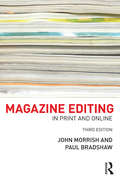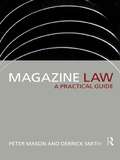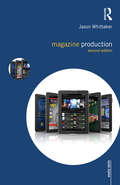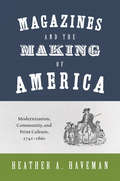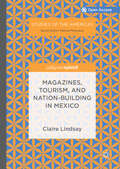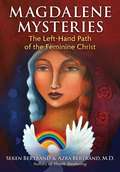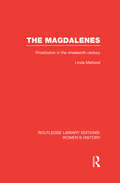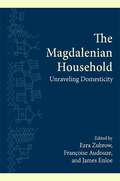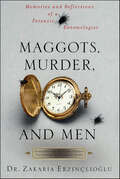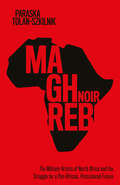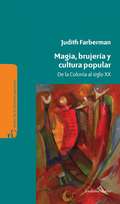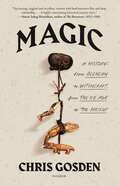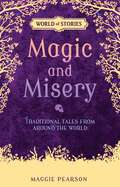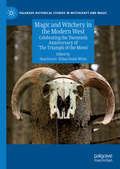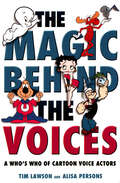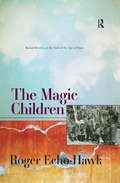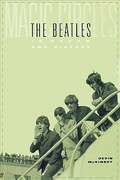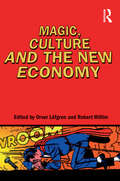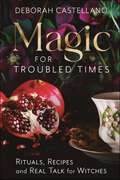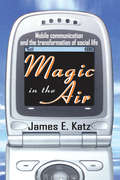- Table View
- List View
Magazine Editing: In Print and Online
by Paul Bradshaw John MorrishIncluding comprehensive coverage on both print and online, consumer and free magazines, Magazine Editing looks at how magazines work and explains the dual role of the magazine editor. John Morrish and Paul Bradshaw consider the editor both as a journalist, having to provide information and entertainment for readers, and as a manager, expected to lead and supervise successfully the development of a magazine or periodical. Looking at the current state of the magazine market in the twenty-first century, the third edition explains how this has developed and changed in recent years, with specific attention paid to the explosion of apps, e-zines, online communities and magazine websites. Featuring case studies, interviews with successful editors, examples of covers and spreads, and useful tables and graphs, this book discusses the editor’s many roles and details the skills needed to run a publication. Magazine Editing offers practical guidance on: how to create an editorial strategy how to lead and manage an editorial team researching a market and finding new readers dealing with budgets and finance working with designers and production staff legal, technological and ethical dilemmas online distribution, social media and search engine optimisation managing information overload how to become an editor.
Magazine Law: A Practical Guide
by Peter Mason Derrick SmithMagazine Law is a comprehensive guide to the law for magazine journalists, editors and managers. Written by a barrister experienced in publishing and copyright law and a former magazine journalist and law lecturer, the book addresses the special needs of the magazine industry and explains the laws that regulate and seek to determine what journalists can and cannot publish, and how these laws are applied in everyday situations.Written specifically for all those in the magazine industry, as well as students of magazine journalism, the authors address issues which directly affect day to day practice. The legal and regulatory framework is illustrated with case studies and up-to-date examples of precedent setting cases.Topics covered include:* the legal process and the distinction between criminal and civil law* the role of the courts and reporting court procedure* defamation, fair-comment and libel* product testing and criticism* copyright and passing off* law for photographers, picture researchers and the use of illustrations* privacy and trespass* competition, lotteries and magazine promotion* sub-editing errors and inaccurate copy* ethical and professional issues facing journalistsCodes of Practice published by the Press Complaints Commission and National Union of Journalists are set out in appendices, as are requirements for the award of a National Vocational Qualification in Periodical Journalism in Press Law and Ethics. A glossary of legal terms is included.
Magazine Production (Media Skills)
by Jason WhittakerMagazine Production presents a guide to the practical processes of taking a magazine from initial idea to final product. This second edition provides important revisions on these production processes by examining the technological and business advancements which have reshaped the magazine industry in the last decade. Brand new chapters document the rise of digital media and identify its impact on magazine creation. They also include new guidance on designing online, tablet and mobile editions, as well as for print. Magazine Production explains the business of magazines in the UK, Europe and North America, and the roles of marketing, publishing and advertising in establishing a successful title. This edition also addresses the move by publishers towards e-commerce, multimedia content and events to promote their brands and sell products. With information on professional bodies such as the Professional Publishers Association, an expert overview of magazine markets and a breakdown of roles within editorial and design departments, this book offers readers practical steps to achieving success in magazine publishing today. Magazine Production includes: • an introduction to the history, markets and audiences of magazines • explanations of the roles of publishers and advertising teams as part of the business of magazines • a comparison between print and new systems of digital circulation, with particular focus on mobile platforms; • guidance on setting up editorial teams, and best practice for producing feature, news and review copy • information on designing and laying out a title for print or digital distribution • legal and ethical issues affecting magazine editors and publishers • a consideration of the future of magazines.
Magazine Writing
by Christopher D. Benson Charles F. WhitakerWhat does it take to launch a career writing for magazines? In this comprehensive, up-to-date introduction to magazine writing, students will learn everything from the initial story pitch all the way through to the final production, taking with them the essential tools and skills they will need for today's rapidly changing media landscape. Written by a team of experienced writers and editors, Magazine Writing teaches the time-tested rules for good writing alongside the modern tools for digital storytelling. From service pieces to profiles, entertainment stories and travel articles, it provides expert guidance on topics such as: developing saleable ideas; appealing to specific segments of the market; navigating a successful pitch; writing and editing content for a variety of areas, including service, profiles, entertainment, travel, human interest and enterprise Chock full of examples of published works, conversations with successful magazine contributors and bloggers, and interviews with working editors, Magazine Writing gives students all the practical and necessary insights they need to jumpstart a successful magazine writing career.
Magazines and the Making of America: Modernization, Community, and Print Culture, 1741-1860
by Heather A. HavemanFrom the colonial era to the onset of the Civil War, Magazines and the Making of America looks at how magazines and the individuals, organizations, and circumstances they connected ushered America into the modern age. How did a magazine industry emerge in the United States, where there were once only amateur authors, clumsy technologies for production and distribution, and sparse reader demand? What legitimated magazines as they competed with other media, such as newspapers, books, and letters? And what role did magazines play in the integration or division of American society? From their first appearance in 1741, magazines brought together like-minded people, wherever they were located and whatever interests they shared. As America became socially differentiated, magazines engaged and empowered diverse communities of faith, purpose, and practice. Religious groups could distinguish themselves from others and demarcate their identities. Social-reform movements could energize activists across the country to push for change. People in specialized occupations could meet and learn from one another to improve their practices. Magazines built translocal communities--collections of people with common interests who were geographically dispersed and could not easily meet face-to-face. By supporting communities that crossed various axes of social structure, magazines also fostered pluralistic integration.Looking at the important role that magazines had in mediating and sustaining critical debates and diverse groups of people, Magazines and the Making of America considers how these print publications helped construct a distinctly American society.
The Magazines Handbook (Media Practice)
by Jenny McKayThe Magazines Handbook is an introductory guide to all aspects of magazine journalism and publishing. The book explores the latest innovations in digital design and delivery, whilst also reaffirming the continued importance of key journalistic skills, including good interviewing, feature writing and news writing. The book includes chapters on the visual aspects of magazines, such as illustration and picture editing, and chapters covering the business background of this increasingly global industry. Jenny McKay offers tips on training and work experience as well as outlining the function of various editorial jobs. Profiles of four young journalists give a flavour of life in the early years of a career. Chapters include: advice on embarking on a career in magazine journalism; an overview of magazine design and the production process; analysis of the state of the magazine industry today, with a look to its future; a discussion of legal issues related to magazine journalism; a glossary of key terms and recommended reading in every chapter. Now in its fourth edition, The Magazines Handbook offers a nuanced and reflective account of periodical journalism, ideal for students of journalism and budding professionals who are seeking a useful starting point for wide-ranging academic discussion about magazines.
Magazines, Tourism, and Nation-Building in Mexico (Studies of the Americas)
by Claire LindsayThis open access book discusses the relationship between periodicals, tourism, and nation-building in Mexico. It enquires into how magazines, a staple form of the promotional apparatus of tourism since its inception, articulated an imaginative geography of Mexico at a time when that industry became a critical means of economic recovery and political stability after the Revolution. Notwithstanding their vogue, popularity, reach, and close affiliations to commerce and state over several decades, magazines have not received any sustained critical attention in the scholarship on that period. This book aims to redress that oversight. It argues that illustrated magazines like Mexican Folkways (1925–1937) and Mexico This Month (1955–1971) offer rich and compelling materials in that regard, not only as unique tools for interrogating the ramifications of tourism on the country’s reconstruction, but as autonomous objects of study that form a vital if complex part of Mexico’s visual culture.
Magdalene Mysteries: The Left-Hand Path of the Feminine Christ
by Seren Bertrand Azra BertrandDiscover the Womb Rites and initiatory magic of Mary Magdalene, who was revered as a Priestess and human embodiment of the Goddess • Reveals how Mary Magdalene was a sacred priestess of the ancient Womb Mysteries, connected to moon wisdom, sacred harlot archetypes, and goddesses in many traditions, including Sophia, Isis, Inanna, Asherah, Lilith, Jezebel, and Witches • Explains how the Magdalene Mysteries have been encoded in Gnostic texts, sacred art, and literature and unveils the secret Grail heresy of the Ghent Altarpiece • Offers rituals and practices to initiate you into the Womb magic of the ancient priestesses and access deeper dimensions of sexuality and feminine power A sacred priestess of the ancient Womb Rites, Mary Magdalene was at the center of a great and enduring Mystery tradition, one that touched on a stream of perennial spiritual wisdom as old as humanity. Worshipped as the human embodiment of the Goddess, the earthly Sophia, her womb was the spiritual luminatrix that anointed and empowered Jesus, transforming him into the Christ. As a priestess of the Goddess, Mary Magdalene knew how to embody the light and the dark, how to harness the magic potency of sacred sexual energy, and how to cleanse, awaken, and resurrect the soul. Yet, even though she sparked the creation of a worldwide religion, her story and teachings have been forgotten. Unveiling the lost left-hand path of the Magdalene, the Feminine Christ, authors Seren and Azra Bertrand explore how this underground stream of knowledge has been carried forward over the millennia through an unbroken lineage of Womb Shamans, Priestesses, Oracles, and Medicine Women. They explain how the Magdalene Mysteries, symbolized by the Rose, have been encoded in Gnostic codices and gospels and in the highest art, literature, and architecture of many ages, including most significantly the Ghent Altarpiece. They examine Mary Magdalene&’s connection to moon wisdom, sacred harlot archetypes, and goddesses in many traditions, including Isis, Inanna, Asherah, Lilith, and Jezebel, and look at shamanic, tantric, and Cathar expressions of sacred feminine mysteries as well as the Witch and Templar roots of Robin Hood and Maid Marian. In this revelatory and magical text on the lost feminine mystery traditions of Mary Magdalene and the lineage of Sophia, the authors present encompassing theological, historical, mythological, and archetypal wisdom, with rituals and practices to initiate you into the Womb magic of the ancient priestesses and the path of the wild feminine.
The Magdalenes: Prostitution in the Nineteenth Century (Routledge Library Editions: Women's History)
by Linda MahoodThe nineteenth century witnessed a discursive explosion around the subject of sex. Historical evidence indicates that the sexual behaviour which had always been punishable began to be spoken of, regulated, and policed in new ways. Prostitutes were no longer dragged through the town, dunked in lakes, whipped and branded. Medieval forms of punishment shifted from the emphasis on punishing the body to punishing the mind. Building on the work of Foucault, Walkowitz, and Mort, Linda Mahood traces and examines new approached emerging throughout the nineteenth century towards prostitution and looks at the apparatus and institutions created for its regulation and control. In particular, throughout the century, the bourgeoisie contributed regularly to the discourse on the prostitution problem, the debate focusing on the sexual and vocational behaviour of working class women. The thrust of the discourse, however, was not just repression or control but the moral reform – through religious training, moral education, and training in domestic service – of working class women. With her emphasis on Scottish 'magdalene' homes and a case study of the system of police repression used in Glasgow, Linda Mahood has written the first book of its kind dealing with these issues in Scotland. At the same time the book sets nineteenth-century treatment of prostitutes in Scotland into the longer run of British attempts to control 'drabs and harlots', and contributes to the wider discussion of 'dangerous female sexuality' in a male-dominated society.
The Magdalenian Household: Unraveling Domesticity (SUNY series, The Institute for European and Mediterranean Archaeology Distinguished Monograph Series)
by Ezra Zubrow Françoise Audouze James G. EnloeWhat was home and family like in Paleolithic Europe? How did mobile hunter-gatherer families live, work, and play together in the fourteenth millennium BP? What were the functional and spatial constraints and markers of their domesticity—the processes that create and sustain a household?Despite the long recognized absence of comprehensive archaeological data on such ancient homes and hearths, the archaeologists in this volume begin unraveling the domesticity of the Upper Paleolithic by drawing on both an immense trove of new material evidence and comparative site data, and a range of incisive and illuminating ethnographic analogies, theoretical models, and simulations. Five Late Magdalenian sites from the Paris Basin and one later Azilian site provide striking evidence of well preserved camps of short duration, situated on valley bottoms and buried by gentle floods. Of particular interest and value is the site of Verberie, rich in lithic tools, faunal remains, hearts, and other indicators of spatial organization, which has been excavated continuously for twenty-six years by the same director and provides an unparalleled source of information on Paleolithic domesticity. The first group of essays and reports look at the technology and demographic evidences of domesticity; the second set seeks clues to the spatial patterning of Paleolithic households; while the final essays draw on ethnographic analogies to reconstruct and interpret gendered divisions of labor, perishable technologies, and other activities not directly recognizable from archaeological remains.
Maggots, Murder, and Men: Memories and Reflections of a Forensic Entomologist
by Zakaria ErzinçliogluThe science of forensic entomology-the application of insect biology to the investigation of crime-is extremely specialized, combining as it does an expert knowledge of entomology with keen powers of observation and deduction. Dr. Erzinclioglu has been a practitioner for over twenty-five years and has been involved in a great number of investigations, including some recent high-profile cases, where his evidence has been critical to the outcome.A great admirerer of Sherlock Holmes, Dr. Erzinclioglu compares his own techniques with those of his fictional hero, and takes the reader behind the often gruesome but deeply fascinating scenes of a murder investigation. This absorbing book ranges over cases from history, prehistory and mythology to the present day and is as gripping and readable as a good thriller.
Maghreb Noir: The Militant-Artists of North Africa and the Struggle for a Pan-African, Postcolonial Future (Worlding the Middle East)
by Paraska Tolan-SzkilnikUpon their independence, Moroccan, Algerian, and Tunisian governments turned to the Global South and offered military and financial aid to Black liberation struggles. Tangier and Algiers attracted Black American and Caribbean artists eager to escape American white supremacy; Tunis hosted African filmmakers for the Journées Cinématographiques de Carthage; and young freedom fighters from across the African continent established military training camps in Morocco. North Africa became a haven for militant-artists, and the region reshaped postcolonial cultural discourse through the 1960s and 1970s. Maghreb Noir dives into the personal and political lives of these militant-artists, who collectively challenged the neo-colonialist structures and the authoritarianism of African states. Drawing on Arabic, Spanish, Portuguese, French, and English sources, as well as interviews with the artists themselves, Paraska Tolan-Szkilnik expands our understanding of Pan-Africanism geographically, linguistically, and temporally. This network of militant-artists departed from the racial solidarity extolled by many of their nationalist forefathers, instead following in the footsteps of their intellectual mentor, Frantz Fanon. They argued for the creation of a new ideology of continued revolution—one that was transnational, trans-racial, and in defiance of the emerging nation-states. Maghreb Noir establishes the importance of North Africa in nurturing these global connections—and uncovers a lost history of grassroots collaboration among militant-artists from across the globe.
Magia, brujería y cultura popular: De la colonia al siglo 20
by Judith FarbermanDe la colección «Nudos de la historia argentina» dirigida por JorgeGelman, una investigación sobre magia y hechicería desde tiempos de laconquista. Sin duda, ciertas creencias y prácticas mágicas han atravesado lossiglos intactas o con muy pocas variaciones. Hoy como ayer, numerosaspersonas creen en la eficacia de la magia, sea para producir elinfortunio como para protegerse de él. Lo que, en cambio, sí ha variadohistóricamente es el lugar que estas creencias y prácticas ocupan en lasdiferentes visiones del mundo y las formas en que se las ha pensado yexplicado.Este libro se ocupa de la persecución de la hechicería durante laColonia y también de los modos en que las prácticas mágicas, entendidascomo supersticiones, fueron juzgadas y conceptualizadas en el siglo XX.Santiago del Estero constituye el corazón geográfico de unainvestigación que, tras rastrear a los «hechiceros» en expedientesjudiciales del siglo XVIII, se ocupa de las supersticiones y de lossupersticiosos en la cultura popular, a través del análisis de laEncuesta Nacional de Folclore de 1920 y del pensamiento de tres ilustresautores santiagueños: Ricardo Rojas, Orestes Di Lullo y Bernardo CanalFeijoo.Para la colección «Nudos de la Historia argentina» hemos pedido ahistoriadores de primer nivel que escriban libros sólidos pero a la vezatractivos, susceptibles de ser leídos y disfrutados por personasinteresadas en la historia, aunque carezcan de una formaciónuniversitaria en la disciplina. Esperamos estar a la altura del desafío.
Magic: From Alchemy to Witchcraft, from the Ice Age to the Present
by Chris GosdenAn Oxford professor of archaeology explores the unique history of magic—the oldest and most neglected strand of human behavior and its resurgence today Three great strands of belief run through human history: Religion is the relationship with one god or many gods, masters of our lives and destinies. Science distances us from the world, turning us into observers and collectors of knowledge. And magic is direct human participation in the universe: we have influence on the world around us, and the world has influence on us.Over the last few centuries, magic has developed a bad reputation—thanks to the unsavory tactics of shady practitioners, and to a successful propaganda campaign on the part of religion and science, which denigrated magic as backward, irrational, and "primitive." In Magic, however, the Oxford professor of archaeology Chris Gosden restores magic to its essential place in the history of the world—revealing it to be an enduring element of human behavior that plays an important role for individuals and cultures. From the curses and charms of ancient Greek, Roman, and Jewish magic, to the shamanistic traditions of Eurasia, indigenous America, and Africa; from the alchemy of the Renaissance to the condemnation of magic in the colonial period and the mysteries of modern quantum physics—Gosden's startling, fun, and colorful history supplies a missing chapter of the story of our civilization. Drawing on decades of research around the world—touching on the first known horoscope, a statue ordered into exile, and the mystical power of tattoos—Gosden shows what magic can offer us today, and how we might use it to rethink our relationship with the world. Magic is an original, singular, and sweeping work of scholarship, and its revelations will leave a spell on the reader.
Magic and Loss: The Internet as Art
by Virginia HeffernanJust as Susan Sontag did for photography and Marshall McLuhan did for television, Virginia Heffernan (called one of the "best living writers of English prose") reveals the logic and aesthetics behind the Internet.Since its inception, the Internet has morphed from merely an extension of traditional media into its own full-fledged civilization. It is among mankind's great masterpieces--a massive work of art. As an idea, it rivals monotheism. We all inhabit this fascinating place. But its deep logic, its cultural potential, and its societal impact often elude us. In this deep and thoughtful book, Virginia Heffernan presents an original and far-reaching analysis of what the Internet is and does. Life online, in the highly visual, social, portable, and global incarnation rewards certain virtues. The new medium favors speed, accuracy, wit, prolificacy, and versatility, and its form and functions are changing how we perceive, experience, and understand the world.
Magic and Loss: The Internet as Art
by Virginia HeffernanJust as Susan Sontag did for photography and Marshall McLuhan did for television, Virginia Heffernan (called one of the "best living writers of English prose") reveals the logic and aesthetics behind the Internet.Since its inception, the Internet has morphed from merely an extension of traditional media into its own full-fledged civilization. It is among mankind's great masterpieces--a massive work of art. As an idea, it rivals monotheism. We all inhabit this fascinating place. But its deep logic, its cultural potential, and its societal impact often elude us. In this deep and thoughtful book, Virginia Heffernan presents an original and far-reaching analysis of what the Internet is and does. Life online, in the highly visual, social, portable, and global incarnation rewards certain virtues. The new medium favors speed, accuracy, wit, prolificacy, and versatility, and its form and functions are changing how we perceive, experience, and understand the world.
Magic and Misery: Traditional Tales from around the World (World of Stories)
by Maggie PearsonA little old man learns the secret behind a magical fiddle. An undersea princess leaves her amber palace for love. A mule waits for revenge on the one who wronged her . . . Explore folktales, myths, legends, and fables from around the world. From magical to funny, tender to terrifying, these stories carry the spirit of diverse cultures and traditions around the world.
Magic and Witchery in the Modern West: Celebrating the Twentieth Anniversary of 'The Triumph of the Moon' (Palgrave Historical Studies in Witchcraft and Magic)
by Shai Feraro Ethan Doyle WhiteThis book marks twenty years since the publication of Professor Ronald Hutton’s The Triumph of the Moon, a major contribution to the historical study of Wicca. Building on and celebrating Hutton’s pioneering work, the chapters in this volume explore a range of modern magical, occult, and Pagan groups active in Western nations. Each contributor is a specialist in the study of modern Paganism and occultism, although differ in their embrace of historical, anthropological, and psychological perspectives. Chapters examine not only the history of Wicca, the largest and best-known form of modern Paganism, but also modern Pagan environmentalist and anti-nuclear activism, the Pagan interpretation of fairy folklore, and the contemporary ‘Traditional Witchcraft’ phenomenon.
The Magic Apple Tree: A Country Year
by Susan HillLooking out from Moon Cottage, Susan Hill records the sights and smells, the people, gardens, animals, births, festivals and deaths that mark the changing seasons in the small Oxfordshire community over a year.
The Magic Behind the Voices: A Who's Who of Cartoon Voice Actors
by Tim Lawson Alisa PersonsThe Magic Behind the Voices is a fascinating package of biographies, anecdotes, credit listings, and photographs of the actors who have created the unmistakable voices for some of the most popular and enduring animated characters of all time. Drawn from dozens of personal interviews, the book features a unique look at thirty-nine of the hidden artists of show business. Often as amusing as the characters they portray, voice actors are charming, resilient people—many from humble beginnings—who have led colorful lives in pursuit of success. Beavis and Butthead and King of the Hill's Mike Judge was an engineer for a weapons contractor turned self-taught animator and voice actor. Nancy Cartwright (the voice of Bart Simpson) was a small-town Ohio girl who became the star protégé of Daws Butler—most famous for Yogi Bear, Huckleberry Hound, and Quick Draw McGraw. Mickey Mouse (Wayne Allwine) and Minnie Mouse (Russi Taylor) were a real-life husband-and-wife team. Spanning many studios and production companies, this book captures the spirit of fun that bubbles from those who create the voices of favorite animated characters. In the earliest days of cartoons, voice actors were seldom credited for their work. A little more than a decade ago, even the Screen Actors Guild did not consider voice actors to be real actors, and the only voice actor known to the general public was Mel Blanc. Now, Oscar-winning celebrities clamor to guest star on animated television shows and features. Despite the crushing turnouts at signings for shows such as Animaniacs, The Simpsons, and SpongeBob Squarepants, most voice actors continue to work in relative anonymity. The Magic Behind the Voices features personal interviews and concise biographical details, parting the curtain to reveal creators of many of the most beloved cartoon voices.
The Magic Children: Racial Identity at the End of the Age of Race
by Roger Echo-HawkOne day at the end of the twentieth century, Roger Echo-Hawk decided to give up being an Indian. After becoming an American Indian historian, he started to question our widespread reliance on a concept of race that the academy had long-since discredited, and embarked on a personal and professional journey to giving up race himself. This passionate book offers a powerful meditation on racialism and a manifesto for creating a world without it. Echo-Hawk examines personal identity, social movements, and policy—NAGPRA, Indian law, Red Pride, indigenous archaeology—showing how they rely on race and how they should move beyond it.
Magic Circles: The Beatles in Dream and History
by Devin McKinneyNo one expressed the heart and soul of the Sixties as powerfully as the Beatles did through the words, images, and rhythms of their music. In Magic Circles Devin McKinney uncovers the secret history of a generation and a pivotal moment in twentieth-century culture. He reveals how the Beatles enacted the dream life of their time and shows how they embodied a kaleidoscope of desire and anguish for all who listened--hippies or reactionaries, teenage fans or harried parents, Bob Dylan or Charles Manson. The reader who dares to re-enter the vortex that was the Sixties will appreciate, perhaps for the first time, much of what lay beneath the social trauma of the day. <P><P>Delving into concerts and interviews, films and music, outtakes and bootlegs, Devin McKinney brings to bear the insights of history, aesthetics, sociology, psychology, and mythology to account for the depth and resonance of the Beatles' impact. His book is also a uniquely multifaceted appreciation of the group's artistic achievement, exploring their music as both timeless expression and visceral response to their historical moment. Starting in the cellars of Liverpool and Hamburg, and continuing through the triumph of Beatlemania, the groundbreaking studio albums, and the last brutal, sorrowful thrust of the White Album, Magic Circles captures both the dream and the reality of four extraordinary musicians and their substance as artists. At once an entrancing narrative and an analytical montage, the book follows the drama, comedy, mystery, irony, and curious off-ramps of investigation and inquiry that contributed to one of the most amazing odysseys in pop culture.
Magic, Culture and the New Economy
by Orvar LöfgrenWhat happens when economies 'heat up'? This book looks at the 1990s, years of intense economic experimentation, when buzz words such as 'network society', 'the experience economy', 'creative cities' and 'glocalization' were everywhere. A fascinating perspective on 'The New Economy' emerges as the authors explore the worlds of coolhunters, biotech brokers, career coaches, software entrepreneurs and event managers and tackle such questions as: - how is magic used in the quest for newness and change? - what happens when cultural techniques such as branding and styling colonize new arenas? - what turns out to be just a flash-in-the-pan and what has a lasting impact? This book is essential reading for anyone wishing to understand how economies operate in periods of rapid transformation.
Magic for Troubled Times: Rituals, Recipes, and Real Talk for Witches
by Deborah CastellanoSpells, Rituals, and Guidance for Your Transformative Journey through Troubled TimesMagic is always possible, even when it's hard to see. No matter what you're struggling with, this book can help you overcome it. Featuring gentle ways to recover and a magical plan of action, Magic for Troubled Times gives you the courage to reach the joyful times in your future.Deborah Castellano sits you down for some real talk on how to navigate difficult waters, whether you're facing a pandemic or a messy breakup. She first helps you get back on your feet, and then she guides each step forward with grounding and healing exercises, protection and money spell work, delicious recipes, and more. From luck and glamour magic to offerings and hexing, this book is full of useful strategies for both getting through the roughest parts of life and making each day better.
Magic in the Air: Mobile Communication and the Transformation of Social Life
by James E. KatzIn this timely volume, James E. Katz, a leading authority on social consequences of communication technology, analyzes the way new mobile telecommunications affect daily life both in the United States and around the world. Magic in the Air is the most wide-ranging analysis of mobile communication to date. Katz investigates the spectrum of social aspects of the cell phone's impact on society and the way social forces affect the use, display, and re-configuration of the cell phone. Surveying the mobile phone's current and emerging role in daily life, Katz finds that it provides many benefits for the user, and that some of these benefits are subtle and even counter-intuitive. He also identifies ways the mobile phone has not been entirely positive. After reviewing these he outlines some steps to ameliorate the mobile phone's negative effects. Katz also discusses use and abuse of mobile phones in educational settings, where he finds that their use is eroding students' participation in class even as it is helping them to cheat on exams and cut class. Parents no longer object to their children having mobile phones in class in a post-Columbine and 9/11 era; instead they are pressing schools to change their rules to allow students to have their phones available during class. And mobile phone misbehavior is by no means limited to students: Katz finds that teachers are increasingly taking calls in the middle of class, even interrupting their own lectures to answer what they claim are important calls. In keeping with the book's title, Katz explores the often overlooked psychic and religious uses of the mobile phone, an area that has only recently begun to command scholarly interest. Magic in the Air will be essential reading for communications specialists, sociologists, and social psychologists.
